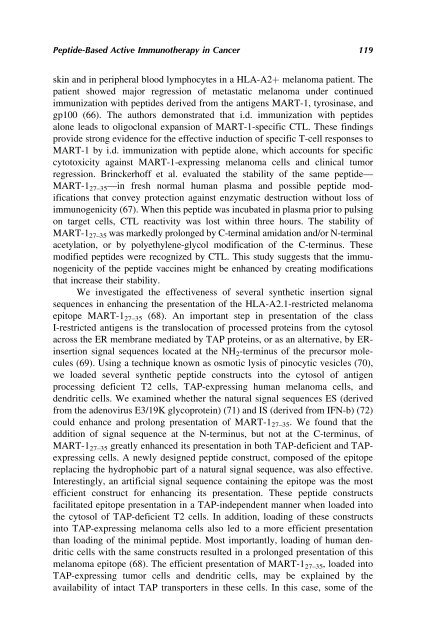Download File - JOHN J. HADDAD, Ph.D.
Download File - JOHN J. HADDAD, Ph.D.
Download File - JOHN J. HADDAD, Ph.D.
You also want an ePaper? Increase the reach of your titles
YUMPU automatically turns print PDFs into web optimized ePapers that Google loves.
Peptide-Based Active Immunotherapy in Cancer 119<br />
skin and in peripheral blood lymphocytes in a HLA-A2þ melanoma patient. The<br />
patient showed major regression of metastatic melanoma under continued<br />
immunization with peptides derived from the antigens MART-1, tyrosinase, and<br />
gp100 (66). The authors demonstrated that i.d. immunization with peptides<br />
alone leads to oligoclonal expansion of MART-1-specific CTL. These findings<br />
provide strong evidence for the effective induction of specific T-cell responses to<br />
MART-1 by i.d. immunization with peptide alone, which accounts for specific<br />
cytotoxicity against MART-1-expressing melanoma cells and clinical tumor<br />
regression. Brinckerhoff et al. evaluated the stability of the same peptide—<br />
MART-127–35—in fresh normal human plasma and possible peptide modifications<br />
that convey protection against enzymatic destruction without loss of<br />
immunogenicity (67). When this peptide was incubated in plasma prior to pulsing<br />
on target cells, CTL reactivity was lost within three hours. The stability of<br />
MART-127–35 was markedly prolonged by C-terminal amidation and/or N-terminal<br />
acetylation, or by polyethylene-glycol modification of the C-terminus. These<br />
modified peptides were recognized by CTL. This study suggests that the immunogenicity<br />
of the peptide vaccines might be enhanced by creating modifications<br />
that increase their stability.<br />
We investigated the effectiveness of several synthetic insertion signal<br />
sequences in enhancing the presentation of the HLA-A2.1-restricted melanoma<br />
epitope MART-127–35 (68). An important step in presentation of the class<br />
I-restricted antigens is the translocation of processed proteins from the cytosol<br />
across the ER membrane mediated by TAP proteins, or as an alternative, by ERinsertion<br />
signal sequences located at the NH 2-terminus of the precursor molecules<br />
(69). Using a technique known as osmotic lysis of pinocytic vesicles (70),<br />
we loaded several synthetic peptide constructs into the cytosol of antigen<br />
processing deficient T2 cells, TAP-expressing human melanoma cells, and<br />
dendritic cells. We examined whether the natural signal sequences ES (derived<br />
from the adenovirus E3/19K glycoprotein) (71) and IS (derived from IFN-b) (72)<br />
could enhance and prolong presentation of MART-127–35. We found that the<br />
addition of signal sequence at the N-terminus, but not at the C-terminus, of<br />
MART-1 27–35 greatly enhanced its presentation in both TAP-deficient and TAPexpressing<br />
cells. A newly designed peptide construct, composed of the epitope<br />
replacing the hydrophobic part of a natural signal sequence, was also effective.<br />
Interestingly, an artificial signal sequence containing the epitope was the most<br />
efficient construct for enhancing its presentation. These peptide constructs<br />
facilitated epitope presentation in a TAP-independent manner when loaded into<br />
the cytosol of TAP-deficient T2 cells. In addition, loading of these constructs<br />
into TAP-expressing melanoma cells also led to a more efficient presentation<br />
than loading of the minimal peptide. Most importantly, loading of human dendritic<br />
cells with the same constructs resulted in a prolonged presentation of this<br />
melanoma epitope (68). The efficient presentation of MART-127–35, loaded into<br />
TAP-expressing tumor cells and dendritic cells, may be explained by the<br />
availability of intact TAP transporters in these cells. In this case, some of the

















